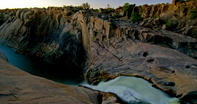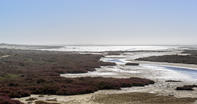Glamour of Prospecting
The copper deposits of northern Namaqualand were well-known, but impossible to exploit as they were simply too far from market. Sooner or later, however, someone was going to give it another try.

After all, money is the root of all invention. The sequel to Dutch governor Simon van der Stel’s expedition of 1685 in search of the “copper mountain”, thus began in 1837 with the arrival of Captain James Edward Alexander, an avid explorer, prospector and hunter. While travelling through the Richtersveld with a local resident, Willem Joseph, the intrepid Alexander came across some particularly rich copper ore at Kodas (about 7 km south of Sendelingsdrif). He collected some samples and forwarded them to Samuel Bennett in Cape Town.
The results were very positive – 27% pure copper – and Bennett approached the British governor, Napier, for a mining permit. Permission was granted and Bennett travelled to England to form a company that would exploit the deposits. Alexander also returned to England and prepared a report on his findings, but it appears that nothing came of this venture.
Strangely, there are many reports that Alexander did commence mining activities at Kodas and Numees; transporting the unprocessed rocks by ox-wagon to the Orange River and then sailing the ore down to the sea on a flat-bottomed boat. Modern researchers, however, can find no proof of this venture and credit the story to a later prospector, Fred Cornell, who wrote a romantic book about the ‘Glamour of Prospecting’ in the Richtersveld.
Untapped Mineral

In the 1840s, a missionary named James Backhouse also visited the copper deposits of Namaqualand and sagely observed that while ‘it might be collected advantageously by Hottentots and transmitted in their skin knapsacks to someplace at the coast where they might exchange it for other commodities; but to smelt it in this country would be impractical (because of a lack of wood or coal)’.
Undeterred, Bennett pushed ahead with his ambitious prospectus for a ‘Cape of Good Hope West Coast Trading and Mining Company’ that sought to set up trading posts, mission stations and mines across the region. This prospectus was issued in 1843 but no investors stepped forward to buy shares in the risky proposition. A few years later, in 1845, another attempt was made to form the ‘South African Mining Company’.
Once again, a glowing picture of untapped mineral wealth was painted, but negative reports from a mining agent put a damper on things. Several contradictory letters from various stakeholders subsequently appeared in the papers. Thomas Fannin, the Honorary Secretary of the South African Mining Company claimed that the mining agent was misled by members of a rival French faction who wanted to take over the mines for themselves.
Opponents to the scheme pointed out that reports from the 1700s found the rock to be too hard to process, that the Orange was not navigable, that there was no fuel or grazing, that there was no suitable harbour on the coast, and so on.
By David Fleminger